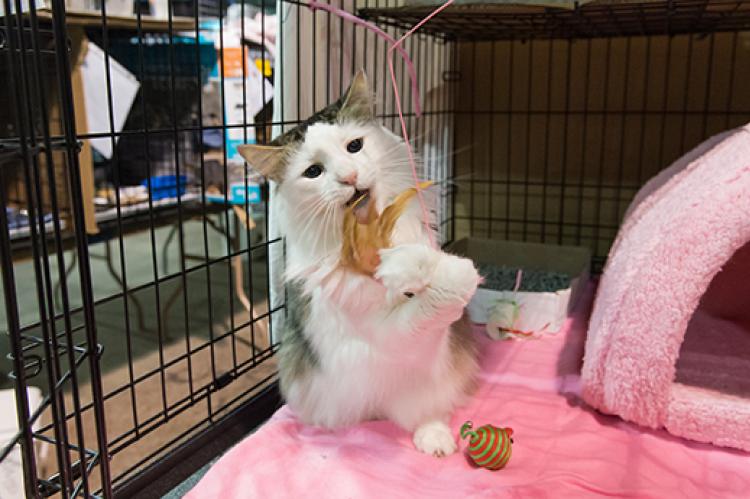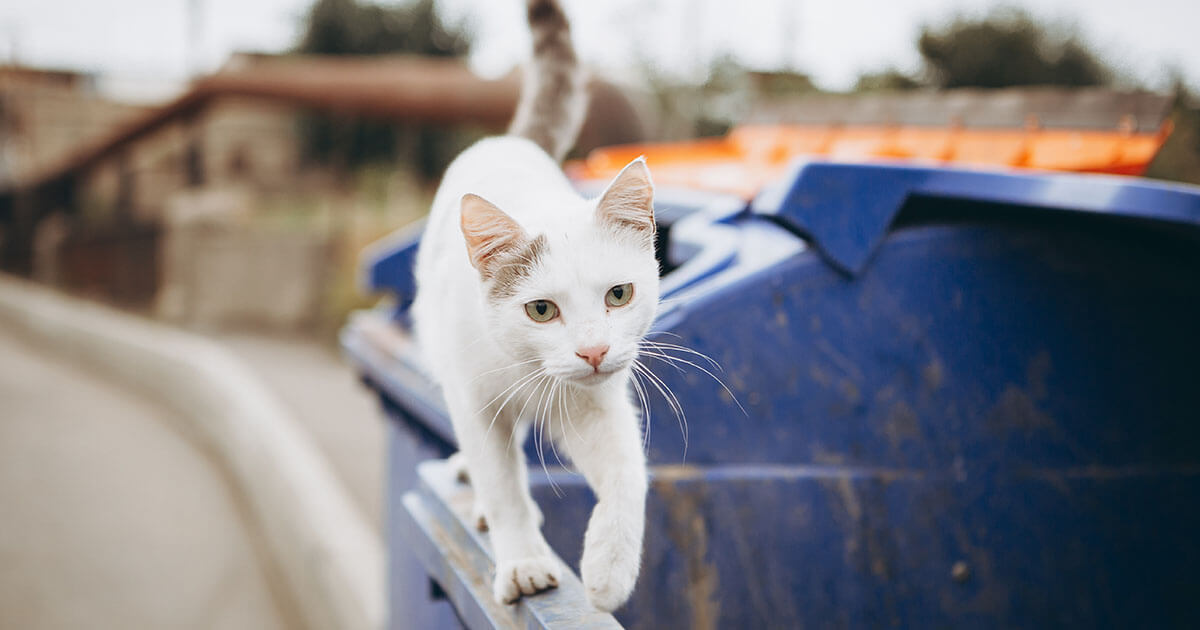Stray cats typically leave their kittens once they reach 8 to 10 weeks old. This is when kittens are usually weaned and can fend for themselves.
As mother cats instinctively prepare their offspring for survival, understanding the weaning process is crucial for those who might come across a litter of stray kittens. During these critical weeks, the mother teaches her young vital life skills such as hunting and shelter seeking.
If you encounter a litter without a mother present, it’s possible she has already considered her kittens independent. Before intervening, it’s important to ensure they truly are abandoned, as the mother may only be away temporarily. Proper timing and assessment can prevent unnecessary separation of kittens from their mother, a key factor to their development and survival in the wild.
Busting Stray Cat Myths
Welcome to the “Busting Stray Cat Myths” section. Here, we discuss common misconceptions. We dive into the secretive lives of stray cats. Today’s focus: mother cat behavior and kitten development stages.
Mother Cat Behavior
Stray cats are mysterious. They have unique parenting tactics. Many believe stray cats abandon their kittens. This is rarely true. Mother cats leave to hunt and forage. They return to nurse. Mothers also move kittens to keep them safe. A mother cat may seem absent. Trust that she is likely nearby.
Kitten Development Stages
Kittens grow fast. Understanding their development helps us know why mothers leave.
- 0-2 Weeks: Kittens are blind and deaf. They stay close to mom.
- 2-4 Weeks: Eyes and ears open. They start exploring.
- 5-8 Weeks: Kittens begin learning survival skills. Mothers may leave longer to encourage independence.
- 8-12 Weeks: Weaning starts. Kittens eat solid food. Mothers leave more frequently.
Mother cats may leave for hours but rarely abandon their kittens before they are ready. If kittens are alone, observe from a distance. Give mother cats a chance to return.
Life Cycle Of Stray Cats
Understanding the life cycle of stray cats helps us protect these feline friends. Stray cats face different challenges at various stages of their life span. Learning about their survival strategies and reproductive patterns is essential.
Survival Strategies
Stray cats are masters of adaptation. They develop key survival skills for thriving in the wild. Here’s a glimpse at how they manage:
- Scavenging: Strays often find food in waste or rely on the kindness of humans.
- Shelter: They seek out safe spots to protect themselves from weather and predators.
- Community: Many stray cats live in colonies, providing mutual aid and comfort.
Social bonds play a critical role in their survival.
Reproductive Patterns
Breeding contributes to the stray population. Understanding their reproductive habits is vital:
- Early Maturity: Female cats can become pregnant as early as five months old.
- Litter Frequency: They can give birth to several litters each year.
- Kitten Care: Mothers care for their kittens until they can survive alone, often by 8 weeks.
Cats’ ability to reproduce quickly adds to the challenge of managing stray populations.
Mother-kitten Bond
The bond between a mother cat and her kittens is both tender and crucial for the young cats’ survival. Understanding when a mother cat might leave her litter provides insight into this natural process.
Early Weeks
During the initial weeks after birth, mother cats are extremely nurturing. Their world revolves around providing warmth, grooming, and milk for their babies. This period is marked by:
- Constant care: The queen, or mother cat, rarely leaves the nest.
- Strong attachment: She fiercely protects her kittens.
- Crucial teaching: Kittens learn basic life skills through observation.
| Age (Weeks) | Mother’s Actions | Kitten’s Development |
|---|---|---|
| 0-2 | Feeding and constant warmth | Eyes begin to open, toddling starts |
| 2-4 | Teaching litter box use | First steps and exploration |
Weaning Period
The weaning period is a transition stage for kittens. It typically starts when they are around 4 weeks old and lasts up to 8 weeks. Mother cats begin encouraging their young to eat solid food. This stage features:
- Introduction of solid food.
- Decreased nursing frequency.
- Increased independence in kittens.
By the end of the weaning period, kittens have usually learned essential survival skills. Consequently, the mother cat might start spending less time with her litter. She instinctively knows they are ready to thrive on their own.
Factors Influencing Separation
The separation of stray cats from their kittens is a natural process. Various factors influence when and why a mother cat may decide it’s time for her offspring to venture out on their own. Understanding these factors can help us support the wellbeing of strays in our neighborhoods.
Resource Availability
The presence of food and water greatly impacts when stray cats may leave their kittens. An environment rich in resources allows mothers to nurture their young longer, ensuring a better chance at survival. Scarce resources, on the other hand, may force a mother to separate sooner, pushing kittens to fend for themselves.
- Kittens stay longer if food is plentiful.
- Lack of resources might lead to earlier separation.
Environmental Threats
Predators and harsh weather conditions pose significant risks to kittens. To protect them, a mother cat might relocate often, sometimes leaving older kittens behind if they are capable of survival.
| Threat Type | Response |
|---|---|
| Predators | Kittens may be left in secure locations. |
| Weather | Mother may change shelters frequently. |
Human Intervention
When humans step in to care for or socialize kittens, the natural timeline can change. Rescue efforts might lead to early separation, especially if fostering or adoption is involved. It’s important for such interventions to be sensitive to the needs of both kittens and their mother.
- Rescues may provide care before mother leaves.
- Early adoption can lead to human-imposed separation.
Supporting Stray Cats Responsibly
Understanding how to support stray cats and knowing when they leave their kittens is vital. It ensures these feral felines and their younglings live healthier and safer lives. This support comes with the responsibility of not disrupting the natural behaviors of strays while aiding their well-being.
Feeding Guidelines
Consider these points when feeding stray cats:
- Consistent feeding spots help minimize the risk of cats roaming into dangerous areas.
- Avoid overfeeding to prevent dependence; moderation is key.
- Use nutritious, dry, or canned cat food instead of table scraps.
- Ensure fresh water is always available, especially in hot climates.
- Maintain a clean feeding area to deter pests.
Health Care Tips
- Contact local animal services or a vet about spay/neuter programs to control the population.
- Vaccinate against common diseases to ensure the safety of the stray and the community.
- Watch for signs of illness or injury and seek professional help when needed.
- Provide basic shelter for protection against weather extremes.
Adoption And Fostering
Adoption can be a joyful outcome for stray kittens:
- Assess the kitten’s health and temperament before considering adoption.
- Connect with local shelters for possible foster programs.
- Use social media to find potential adopters within your community.
- Prepare the kittens for domestic life with gentle human interaction.
- Ensure permanent homes are safe and loving environments.

Credit: us.macmillan.com
Monitoring Kitten Progression
Observing the way stray cat litters grow and change is both fascinating and complex. Monitoring Kitten Progression becomes crucial to understand when these young felines start to venture on their own. Noticing the subtle changes in their behavior and physical growth can provide insights into the bonding period’s length.
Growth Milestones
Keeping an eye on kittens’ growth milestones is key to assessing their development. Kittens experience rapid changes in a short timeframe, which are indicators of future independence. The following table showcases these crucial stages:
| Age | Milestone | Description |
|---|---|---|
| 0-2 weeks | Eyes and Ears Open | Kittens open their eyes and ears, beginning to explore their senses. |
| 3-4 weeks | First Steps | Their first wobbly steps mark the start of physical independence. |
| 5-8 weeks | Weaning Starts | Kittens gradually shift from milk to solid food. |
| 2-4 months | Play Behavior | Play becomes critical for learning social cues and hunting skills. |
| 4-6 months | Independence | Fully weaned and starting to show signs of individual behavior. |
Signs Of Independence
- Self-feeding: Kittens nibble on solid foods, reducing reliance on their mother.
- Exploration: Curiosity leads them to wander from the nest area.
- Play Fighting: Kittens interact with siblings, preparing for solo survival.
- Grooming: They start self-grooming, an essential survival skill.
When these behaviors become consistent, stray kittens are nearing the time to leave their mother. Mothers might then begin the process of gradually distancing themselves as the kittens grow more capable daily.
Intervention And Care
Intervention and care are crucial when dealing with stray cats and their kittens. Understanding when to step in, how to provide care, and eventually finding them permanent homes, are essential steps in helping these animals. Stray cats often face harsh conditions, and their kittens are vulnerable. Knowing the right time to intervene can save lives and promote their well-being.
When To Step In
It’s important to observe the situation before acting. Look for these signs:
- Mom cat has not returned for several hours
- Kittens are in immediate danger or distress
- Loud, continuous crying from the kittens
- Visible signs of illness or injury
Act promptly if you notice any of these signs. Your intervention could be life-saving.
Providing Proper Care
Once you’ve decided to step in, ensure you’re ready to provide care. Essential items include:
| Item | Purpose |
|---|---|
| Kitten Formula | Feeding |
| Blankets | Warmth |
| Safe Space | Security |
| Litter Box | Hygiene |
Contact a vet for medical advice. Offering proper nutrition and a warm environment are key to their survival.
Finding Permanent Homes
Once the kittens are healthy and socialized, it’s time for the next step:
- Reach out to local rescues or shelters
- Use social media to find potential adopters
- Screen adopters carefully to ensure a good match
Ensuring the kittens find safe, loving homes is the ultimate goal. Networking and community outreach can significantly help in this process.

Credit: resources.bestfriends.org

Credit: www.amazon.com
Frequently Asked Questions For When Do Stray Cats Leave Their Kittens
Do Stray Cats Give Their Kittens Away?
Stray cats do not actively give their kittens away. They might abandon them if they’re unable to care for them or if they sense danger.
How Do You Tell If A Mother Cat Has Abandoned Her Kittens?
A mother cat may have abandoned her kittens if she doesn’t return for several hours, avoids the nest, or shows disinterest in feeding or caring for her young. Observe her behaviors closely to determine if intervention is necessary.
How Often Do Stray Kittens Survive?
Stray kittens face daunting survival odds, with only about 25% reaching adulthood without human intervention. Prompt rescue and care significantly increase their chances.
How Long Do Cats Nurse Their Kittens?
Cats typically nurse their kittens for about 8 to 10 weeks before they gradually wean them onto solid food. During this time, the mother provides all necessary nutrients through her milk.
Conclusion
Understanding the behavior of stray cats with their kittens is vital for anyone wanting to assist these felines. Typically, a mother cat will part ways with her offspring when they’re around 8-12 weeks old. Remember that each cat’s journey is unique, and various factors influence their timing.
Assisting in their health and safety can ensure all have the best chance for a thriving life.

